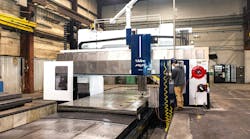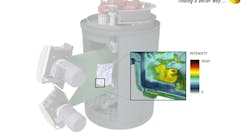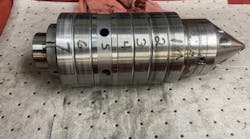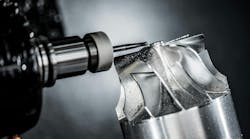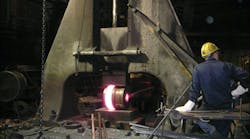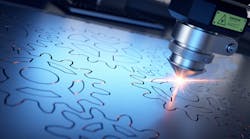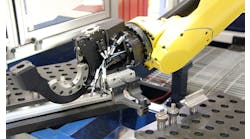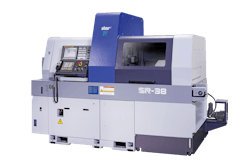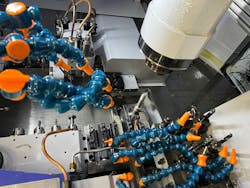High-volume machining of complex precision parts poses many challenges. Standard CNC lathe and milling operations can result in high cycle times and labor costs and may not meet precision tolerances. The use of newer Swiss-style machines allows operators to process all sides of the part in one operation, significantly lowering costs. These Swiss-style machines are very compact compared to standard lathes; less time wasted going from tool to tool can also result in faster cycle times.
Benefits of Swiss-Type Machines
The Swiss turning machine, also called a Swiss-style lathe or Swiss-type machine, is a type of turning machine that can produce high production rates in small parts (1.25 in. diameter and under) while holding excellent tolerances. The unique design allows for the tooling to perform machining operations in very close proximity to the supporting collet/guide bushing. The machines can be coupled with other attachments that can produce highly accurate, mass-produced small parts fast and easily.
Originally invented in the 1880s to help Swiss watchmakers produce smaller and smaller components for more portable products like wristwatches, they allow for very small parts to be machined while being supported during the entire machining process.
A Swiss-type machine feeds the stock through a guide bushing, which means the outer diameter (OD) turning tool can always cut the stock near the bushing, and therefore near the point of support, no matter how long the workpiece. The machine feeds the work out of the spindle and past the tool as it goes. This makes the CNC Swiss-type particularly effective for long and slender turned parts.
Today’s manufacturers are moving from standard CNC-type lathing and milling machines to Swiss-style machines for high-quality, high-volume parts. Where a standard CNC setup may involve four different setup processes (each with different setup personnel who may be in different departments), the Swiss-style machines can produce the part in one setup process in one machine. The tolerances are held in one machine, making it more accurate than when parts are moved from one machine to another (to another). There is more structure when one piece of equipment is used.
“Getting the part “done in one” operation involves less handling and labor, which allows the operator to run multiple machines to reduce the labor burden on multiple jobs at one time,” explains Jeff Geis, Manufacturing Engineer at Wauseon Machine. “The machines significantly decrease overall cycle time. While a standard process may enable shorter cycle time for each individual turning or milling operation, at the end of a 4-operation process the total time may be 5 minutes. With the Swiss style, the cycle may be 2.5 minutes for one machine, but in that time the operator can load the material, leave the machine and go to another piece of equipment—and then load another part or parts. Labor use rises because the worker can work on several different pieces of equipment.”
The ability to do milling and turning work at the same time results in very versatile part processing. Planning the best equipment to be used always requires a hard look at the part, the location of the operation, and the processes involved.
Swiss-Style Machines and the Parts They Produce
One example is a fully attended part that previously took 1 minute and 25 seconds to complete on a standard machine. The cycle included hand-loading 3-ft bars into a 3-ft bar feeder and pulling parts from the parts catcher basket. Operators ran about 42 pieces per hour.
When run in Wauseon’s Swiss-type lathe (Star CNC Machine Tool Corp.’s SR-38 Type B 10-Axis CNC Swiss-type Automatic Lathe), the cycle was completed in 36 seconds. No handling was required other than loading 12-ft bars into the bar feeder and pulling finished parts from a bucket of cleaning solution. Operators can run about 100 pieces per hour.
The machine has built-in main- and sub-spindles and high tool post rigidity that ensures exceptional accuracy. Designed for two-tool turning, heavy material removal, and/or rough and finished tooling, the machine has an 8-position backworking unit for complex parts production in one operation that produces the precision and accuracy required by quality critical applications.
Another example was a more complex part that required multiple machines and setups. The part required hand loading 12-ft bars and pulling half-finished parts from a parts catcher, and then hand loading each individual part in for the second operation, in a separate machine. The second operation cycle was 45 seconds or 80 pieces per hour, with a net throughput of 80 pieces per hour at 100% labor.
With the Swiss-type machine, the entire cycle time was 24 seconds. No handling was required other than loading 12-ft bars into the bar feeder and pulling finished parts from a bucket of cleaning solution. The part now runs at 150 pieces per hour at 50% labor.
Another option is Marubeni Citizen-Cincom, Inc.’s Cincom L20 Series, which offers two types of gang tool post, five types of opposite tool post, and three types of back tool post that can be specified for simple to complex workpieces and for small, medium, and large lot sizes.
Quality Precision Parts at a Lower Cost
When a process is fairly simple and does not require a lot of work on both sides of a part, it may be simple to use a couple of lathes back to back and run both. If a part is more complex, using the Swiss-style machines makes sense because the machines can work on all sides in one operation. Having the cycle run unattended means the operator can walk away and run something else. This can take labor off the part, resulting in a lower price.

